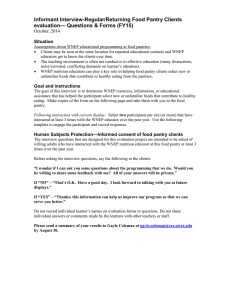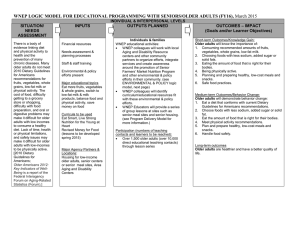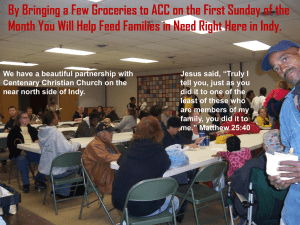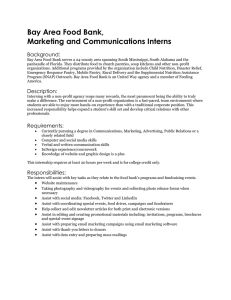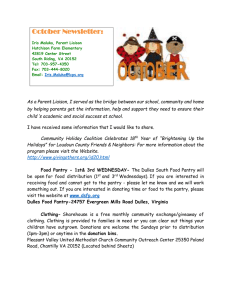WNEP LOGIC MODEL FOR EDUCATIONAL PROGRAMMING AT FOOD PANTRIES (FY16), SITUATION/
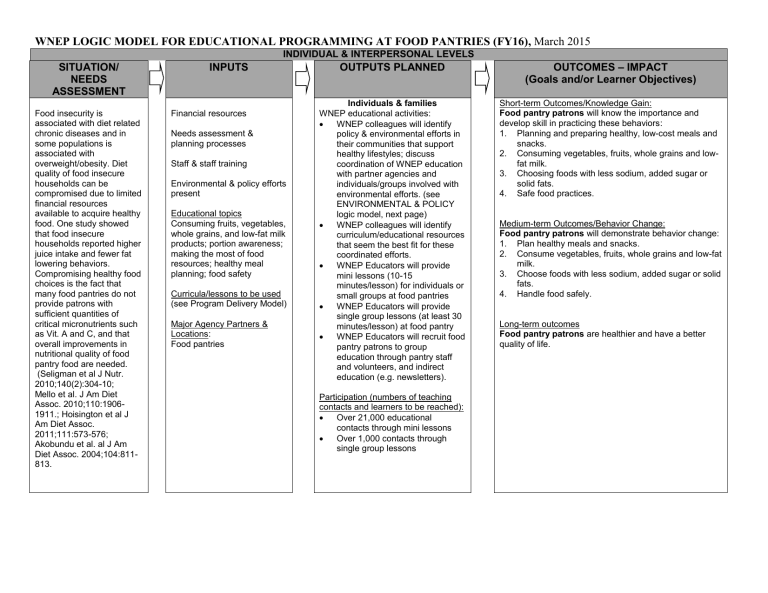
WNEP LOGIC MODEL FOR EDUCATIONAL PROGRAMMING AT FOOD PANTRIES (FY16), March 2015
INDIVIDUAL & INTERPERSONAL LEVELS
SITUATION/
NEEDS
ASSESSMENT
Food insecurity is associated with diet related chronic diseases and in some populations is associated with overweight/obesity. Diet quality of food insecure households can be compromised due to limited financial resources available to acquire healthy food. One study showed that food insecure households reported higher juice intake and fewer fat lowering behaviors.
Compromising healthy food choices is the fact that many food pantries do not provide patrons with sufficient quantities of critical micronutrients such as Vit. A and C, and that overall improvements in nutritional quality of food pantry food are needed.
(Seligman et al J Nutr.
2010;140(2):304-10;
Mello et al. J Am Diet
Assoc. 2010;110:1906-
1911.; Hoisington et al J
Am Diet Assoc.
2011;111:573-576;
Akobundu et al. al J Am
Diet Assoc. 2004;104:811-
813.
INPUTS
Financial resources
Needs assessment & planning processes
Staff & staff training
Environmental & policy efforts present
Educational topics
Consuming fruits, vegetables, whole grains, and low-fat milk products; portion awareness; making the most of food resources; healthy meal planning; food safety
Curricula/lessons to be used
(see Program Delivery Model)
Major Agency Partners &
Locations:
Food pantries
OUTPUTS PLANNED
Individuals & families
WNEP educational activities:
WNEP colleagues will identify policy & environmental efforts in their communities that support healthy lifestyles; discuss coordination of WNEP education with partner agencies and individuals/groups involved with environmental efforts. (see
ENVIRONMENTAL & POLICY logic model, next page)
WNEP colleagues will identify curriculum/educational resources that seem the best fit for these coordinated efforts.
WNEP Educators will provide mini lessons (10-15 minutes/lesson) for individuals or small groups at food pantries
WNEP Educators will provide single group lessons (at least 30 minutes/lesson) at food pantry
WNEP Educators will recruit food pantry patrons to group education through pantry staff and volunteers, and indirect education (e.g. newsletters).
Participation (numbers of teaching contacts and learners to be reached):
Over 21,000 educational contacts through mini lessons
Over 1,000 contacts through single group lessons
OUTCOMES
– IMPACT
(Goals and/or Learner Objectives)
Short-term Outcomes/Knowledge Gain:
Food pantry patrons will know the importance and develop skill in practicing these behaviors:
1. Planning and preparing healthy, low-cost meals and snacks.
2. Consuming vegetables, fruits, whole grains and lowfat milk.
3. Choosing foods with less sodium, added sugar or solid fats.
4. Safe food practices.
Medium-term Outcomes/Behavior Change:
Food pantry patrons will demonstrate behavior change:
1. Plan healthy meals and snacks.
2. Consume vegetables, fruits, whole grains and low-fat milk.
3. Choose foods with less sodium, added sugar or solid fats.
4. Handle food safely.
Long-term outcomes
Food pantry patrons are healthier and have a better quality of life.
WNEP LOGIC MODEL FOR EDUCATIONAL PROGRAMMING AT FOOD PANTRIES (FY16), March 2015
INPUTS
ENVIRONMENTAL & POLICY LEVELS
OUTPUTS PLANNED OUTCOMES – IMPACT
(Goals and/or Objectives)
Major Agency Partners & Locations:
Food pantries, food resource networks/coalitions, resource centers, food donors and food drive organizers, food procurement sources (grocery stores,
TEFAP, food banks, etc.), policy/decision makers
Local, State, and Federal policies:
Dietary Guidelines for Americans
Farm Bill, The Emergency Food Assistance
Program (TEFAP)
Food & beverage marketing and media regulations
Existing efforts in community:
Organizational policy & environmental changes at food pantry to enhance nutritional quality and safety of food pantry foods
Food donor education and commitment to supporting safe & healthy food pantries (including presence of community/school/giving gardens)
Coalition work in community
Other Cooperative Extension work in community
(eg, financial literacy or parenting efforts, Master
Gardeners, urban/community planning, local foods)
Opportunities in community (e.g., access to healthy, affordable food, opportunities for safe, affordable physical activity for families)
Tools
Safe & Healthy Food Pantries Project (available spring 2015)
Food challenge simulation and other PACE tools to raise awareness of poverty, food insecurity and health equity
Needs assessment & planning processes
Evaluation and monitoring processes
Training, technical assistance and resources/tools from state partners (eg, State Specialists, state agencies)
Financial resources:
Grants, local businesses, etc.
Efforts to increase partnerships and interconnectivity among partners
Efforts to increase skills/resources/tools for communities/partners to address obesity
Established community-wide common agenda and goals around key messages:
Increase consumption of fruits, vegetables, whole grains, low-fat milk
Increase physical activity and decrease screen time
Maintain appropriate calorie balance during each stage of life
Efforts to increase awareness of poverty and health equity, and reduce disparities in access to healthy, safe, affordable food and safe, affordable opportunities for physical activity
Monitoring and evaluation of efforts
Short-term Outcomes:
Stronger partnerships and interconnectivity among partners.
Increased awareness of nutrition, food security obesity prevention priorities.
Medium-term Outcomes
Increased:
Increased number of policy, systems and environmental changes that support families with lowincome in choosing healthier food and beverages, and being more food secure.
Increased number of policy, systems and environmental changes that support families with lowincome in being more physically active.
Increased number of families with low-income reached with policy, systems and environmental changes that support families choosing healthier food and beverages, and being more food secure.
Increased number of families with low-income reached with policy, systems and environmental changes that support families to be more physically active.
WNEP LOGIC MODEL FOR EDUCATIONAL PROGRAMMING AT FOOD PANTRIES (FY16), March 2015
EVALUATION QUESTIONS (What do you want to know and How will you find out?)
Indicators for short-term outcomes for food pantry patrons [single or mini lesson]
Number of food pantry patrons who report intent to:
Make at least half their plate fruits and veggies.
Try something they learned from lesson to eat more whole grains.
Choose foods and drinks with little or no added sugars.
Try something they learned from lesson to plan and prepare healthy, low-cost meals and snacks.
Try something they learned from lesson to keep food safe to eat.
Indicators for Medium-term Outcomes for Community Coalitions/partners working with WNEP
Number of WNEP colleagues who report working with coalitions/partners to develop and implement environment and/or policy changes that make healthful food and physical activity practices for food pantry patrons easier/more affordable.
Number and description of environment and/or policy changes to make healthful food and physical activity practices for food pantry patrons easier/more affordable.
